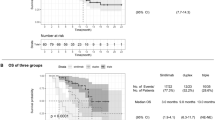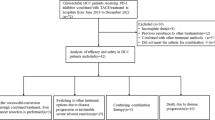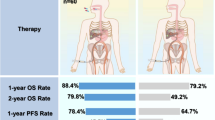Abstract
We conducted a randomized, controlled trial comparing 5-fluorouracil (5-FU) with or without biological response modifiers (BRMs) as a maintenance therapy for hepatocellular carcinoma (HCC) after treatment with percutaneous ethanol injection (PEI), transcatheter arterial embolization (TAE) or arterial infusion of antitumor agents (AI). A total of 58 cases of HCC were classified into 4 groups as follows: group I, PSK with 5-FU (n=15); group II, lentinan with 5-FU (n=15); group III, OK-432 with 5-FU (n=12); and group IV, 5-FU alone as the control (n=16)., The mean survival time, mortality rate, time to progression, and T4/T8 ratio of lymphocytes in the peripheral blood were compared among the four groups. There was no significant difference in the background factors among the groups. In group I, the T4/T8 ratio of lymphocytes was reduced after the therapy. No significant difference was found among the groups in terms of the mean survival time, mortality rate, or time to progression. PEI for mitial therapy was superior to the other therapies in terms of the mean survival time and mortality rate. These results suggest that the addition of BRM to maintenance therapy with 5-FU exerts no prognostic benefit on HCC patients treated with PEI, TAE, or AI.
Similar content being viewed by others
References
Arai Y, Endo T, Kido C (1990) Arterial infusion chemotherapy for the treatment of Cancer. Saishin Igaku 45: 2153
Hirai K, Horii Y, Shimizu M, Inoue J, Hara Y, Kubo Y, Hirayama S, Okumura M, Tanikawa K, Ogawa N (1988) Effects of immunotherapy after TAE therapy for hepatocellular carcinoma (in Japanese) Kan Tan Sui 17: 165
Kennedy PS, Lahane DE, Smith FE (1977) Oral fluorouracil therapy of hepatoma. Cancer 39: 1930
Lin DY, Liaw YF, Lee TY, Lai CM (1988) Hepatic arterial embolization in patients with unresectable hepatocellular carcinoma—a randomized controlled trial. Gastroenterology 94: 453
Linki JS, Bateman JF, Paroly WS (1977) 5-Fluorouracil in hepatocellular carcinoma. Cancer 39: 1936
Nishioka M, Kodama T, Noda K, Fukumoto Y, Kan T, Fujii R, Nawata J, Matsuda A, Sasaki M, Hasegawa M, Okita K, Harada T, Nishimura H, Mizuta M, Takemoto T (1979) Chemotherapy of liver carcinoma. II. Clinical significance of the host's cellular immune state. Acta Hepatol Jpn 20: 491
Nomoto K, Matsuo K (1988) Role of immunopotentiators in immunotherapy. Cancer Chemother 5: 1135
Takezaki E, Murakami S, Nishibayashi H, Kagawa K, Ohmori H (1990) Clinical study of lentinan therapy as an immunomodulator in 15 patients with inoperable hepatocellular carcinoma (in Japanese). Gastroenterology 12: 600
Tanikawa K, Majima Y (1993) Percutaneous ethanol injection therapy (PEIT) for early hepatocellular carcinoma. Gastroenterol Surg 16: 63
Author information
Authors and Affiliations
Rights and permissions
About this article
Cite this article
Suto, T., Fukuda, S., Moriya, N. et al. Clinical study of biological response modifiers as maintenance therapy for hepatocellular carcinoma. Cancer Chemother. Pharmacol. 33 (Suppl 1), S145–S148 (1994). https://doi.org/10.1007/BF00686688
Issue Date:
DOI: https://doi.org/10.1007/BF00686688




